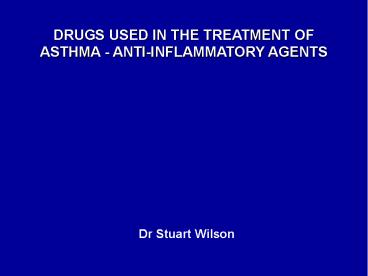DRUGS USED IN THE TREATMENT OF ASTHMA - ANTI-INFLAMMATORY AGENTS - PowerPoint PPT Presentation
Title:
DRUGS USED IN THE TREATMENT OF ASTHMA - ANTI-INFLAMMATORY AGENTS
Description:
drugs used in the treatment of asthma - anti-inflammatory agents dr stuart wilson drugs used in the treatment of asthma - anti-inflammatory agents glucocorticoids ... – PowerPoint PPT presentation
Number of Views:489
Avg rating:3.0/5.0
Title: DRUGS USED IN THE TREATMENT OF ASTHMA - ANTI-INFLAMMATORY AGENTS
1
DRUGS USED IN THE TREATMENT OF ASTHMA -
ANTI-INFLAMMATORY AGENTS
Dr Stuart Wilson
2
DRUGS USED IN THE TREATMENT OF ASTHMA -
ANTI-INFLAMMATORY AGENTS
CORTICOSTEROIDS Adrenal cortex synthesises two
major classes of steroid hormone that are
released into the circulation. Not pre-stored,
but synthesised and released on demand.
- Glucocorticoids the main hormone is cortisol
(hydrocortisone) - regulates numerous processes
that are essential to life, e.g - carbohydrate and protein metabolism
- responses to stress
- inflammatory responses
3
Mineralocorticoids mainly aldosterone -
regulates the retention of salt (and water) by
the kidney
Synthesis and release of aldosterone are
regulated mainly by the renin-angiotensin system
(see Cardiovascular and Renal blocks)
- Naturally occurring steroids may possess both
glucocorticoid and mineralocorticoid actions. The
latter are unwanted in treatment of inflammatory
conditions
- Synthetic derivatives of cortisol, that have
little, or no, mineralocorticoid activity are
frequently used for their anti-inflammatory
effect in the treatment of asthma and many other
conditions. They have no direct bronchodilator
action and are ineffective in relieving
bronchospasm when given acutely
4
MOLECULAR MECHANISM OF ACTION OF STEROID HORMONES
- The receptor steroid complex moves to the nucleus
(4) and binds to steroid response elements in DNA
- The transcription of specific genes (5) is either
switched-on (induced) or switched off
(repressed) to alter mRNA levels (6) and the rate
of synthesis (7) of mediator proteins (8)
5
GLUCOCORTICOID EFFECTS UPON GENE TRANSCRIPTION
THAT ARE RELEVANT TO INFLAMMATION IN BRONCHIAL
ASTHMA
Many tens of genes are regulated by
glucocorticoids acting at GREs, or by modifying
chromatin (via deacetylation of histones not
discussed here)
Gene activation (generally high doses of
glucocorticoids) Examples Annexin-1
(lipocortin-1) ?-adrenoceptors I?B-? (inhibitor
of the inflammatory transcription factor NF-?B)
Gene repression (occurs with low doses of
glucocorticoids) Examples Cytokines Chemokines Ad
hesion molecules Inflammatory enzymes Inflammatory
receptors
6
GLUCOCORTICOID EFFECTS UPON GENE TRANSCRIPTION
THAT ARE RELEVANT TO INFLAMMATION IN BRONCHIAL
ASTHMA (Example 1)
- Gene induction
- Increased synthesis of annexin-1 (lipocortin-1),
a polypeptide inhibiting the enzyme phospholipase
A2, decreases the formation of leukotriene
spasmogens (LTC4, LTD4) and chemotaxins (LTB4) by
reducing the formation of precursor arachidonic
acid.
7
GLUCOCORTICOID EFFECTS UPON GENE TRANSCRIPTION
THAT ARE RELEVANT TO INFLAMMATION IN BRONCHIAL
ASTHMA (Example 2)
8
CELLULAR EFFECTS OF GLUCOCORTICOIDS RELEVANT TO
ASTHMA
From Barnes, P.J. (2006). Eur. J. Pharmacol. 533,
2-14.
9
CLINICAL USE OF GLUCOCORTICOIDS IN ASTHMA
Glucocorticoids suppress the inflammatory
component of asthma (1) prevent inflammation
and (2) resolve established inflammation
Short term, they do not alleviate early stage
bronchospasm caused by allergens, or exercise,
but long term treatment is effective very
effective (particularly in combination with a
long-acting ?2-adrenoceptor agonist)
- In mild/moderate asthma
- Glucocorticoids (often beclomethasone) are given
by inhalation from a metered dose inhaler (to
minimise many unwanted systemic effects) - Efficacy develops over several days
10
- In chronic, severe, or rapidly deteriorating
asthma - Oral prednisolone may be used in combination with
an inhaled steroid to reduce the oral dose
required and minimise unwanted systemic effects.
Bronchodilator drugs are co-administered
(See lectures by Prof. Lipworth for greater
clinical detail)
11
CROMOGLYCATES
- Are second line drugs used prophylactically in
the treatment of asthma (particularly children)
- Have no direct effect upon bronchial smooth muscle
- Have an uncertain molecular mechanism of action.
A decrease in the sensitivity of irritant
receptors associated with sensory C-fibres that
trigger exaggerated reflexes and reduction of
cytokine release are potential mechanisms
- SPECIFIC AGENT
- Sodium cromoglycate
- delivered by inhalation
- can reduce both phases of an asthma attack, but
efficacy may take several weeks to develop - Is the anti-inflammatory of choice in some
children
12
- Binds IgE via Fc to prevent attachment to Fc?
receptors suppresses mast cell response to
allergens
- Reduces the expression of Fc? receptors on
various inflammatory cells































